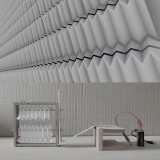Supervisor:
2016
The research begins with the interpretation of the government architecture and its connection with the kinetic architecture, seeking their origins. Several issues, which have concerned architects, designers and government people since 1960s, are cited. Moreover, the evolution which exists nowadays and some conclusions, which have been drawn concerning kinetic architecture, are presented. During the analysis the meaning of motion which resides in the formation of buildings as living organisms, is interpreted considering the various possibilities of movement. In addition, a reference is made to engineering as a science and to simple engines which are capable of provoking motion with comparatively little force. Prior to the presentation of the experiment, several new materials, which are being used in architecture and the so called clever materials that enclose the property of motion are presented focusing on the nickel and titanium alloy (Nitinol and Flexinol), which comprised the materials of our experimentation. After the experiment completion several conclusions are reported concerning the use of flexinol on dynamic parts of the facades. Aiming at the study of a model shade, several principles of the bioclimatic design and the function of the façade when handling the environmental changes, are reported. In the end the study of the shade is conducted, combining the basic principles in order to accomplish thermal and visual comfort and a way of using the shade is suggested with the aid of a mechanism which functions with the clever material flexinol and activates with the sun.
